As the wide, peri-urban expanse of the Greater Toronto Area in Ontario turns into rolling hills of soy, corn, and wheat, we leave behind the sprawling subdivisions of Mississauga and Brampton, entering bucolic farmland peppered with crops, farmhouses, barns, and the occasional country estate.
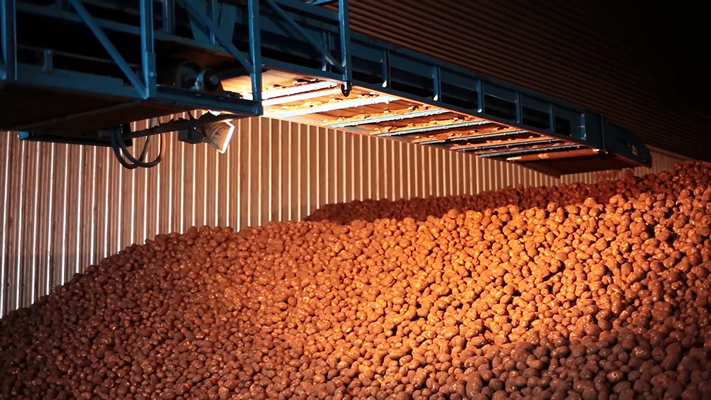
It’s 9:00 am as we pull into Sunrise Potatoes: a large-scale chipping potato farm and storage site located just outside of Alliston, Ontario, owned and operated since 1991 by Dr. Peter VanderZaag and his family. Peter is a third-generation potato farmer whose family emigrated from the Netherlands in the early 1940’s. He is well known and respected in the Ontario’s potato production sector for being both successful and innovative, and between him and his extended family, the VanderZaags are responsible for about 25% of potatoes grown in this province. As we park the car beside a lineup of semi-trucks sporting Frito-Lay logos, Peter appears, greeting us with a smile.
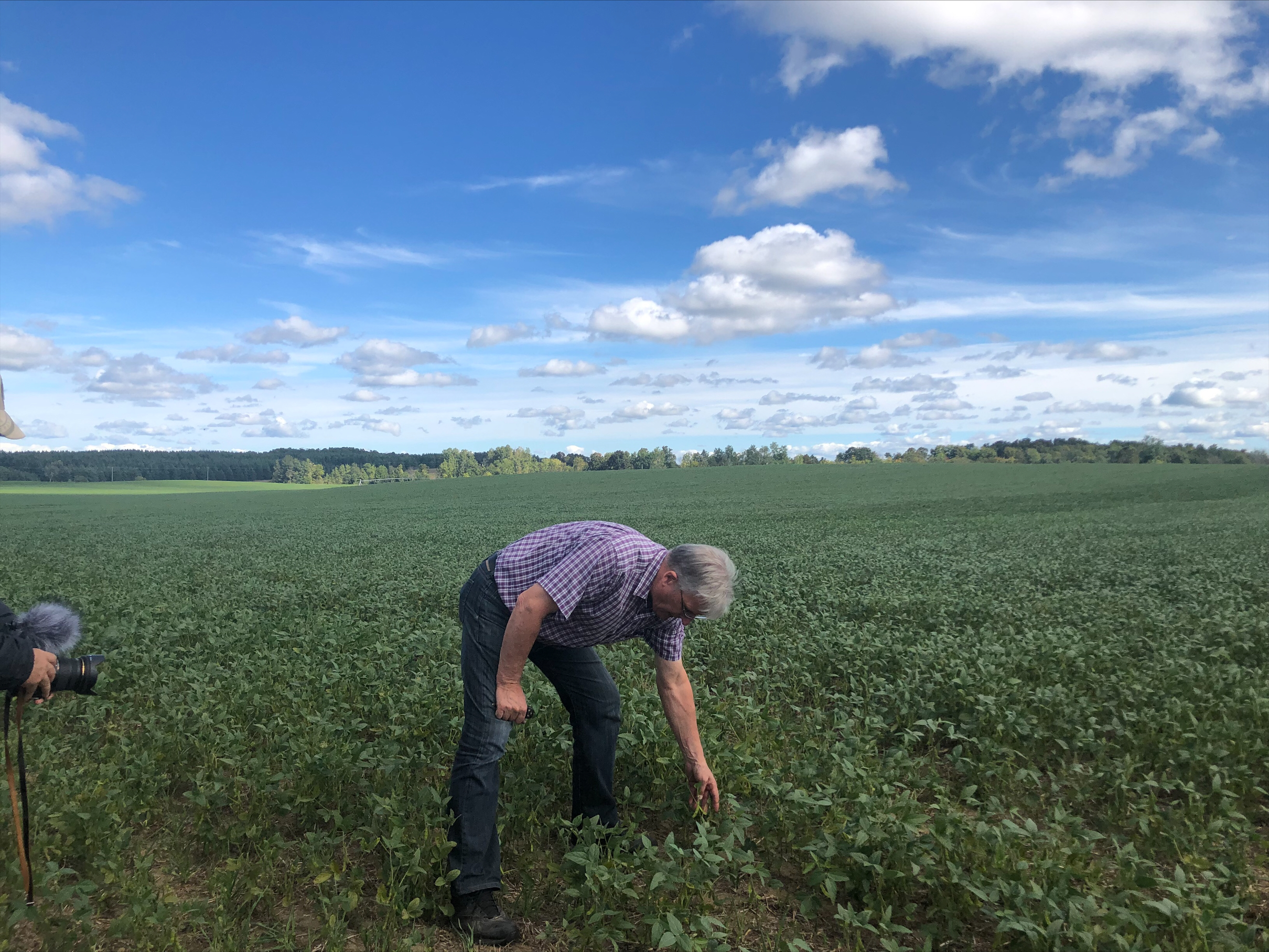
“I hope you wore comfortable shoes”, Peter calls out to us over the loud hum of sorting equipment, “today I’m going to show you around the facilities. I want you to see what I mean when I talk about ‘Best Management Practices’”. In the words of the Ontario Ministry of Agriculture, Food and Rural Affairs (OMAFRA), “Best Management Practices” (or ‘BMPs’) are ‘practical, affordable, approach[es] to conserving a farm's soil and water resources without sacrificing productivity’. They make up a diverse set of practices, and they’re important to consider when we talk about ‘agricultural sustainability’ which we define here as "the efficient production of safe, high-quality agricultural product, in a way that protects and improves the natural environment, the social and economic conditions of the farmers, their employees and local communities, and safeguards the health and welfare of all farmed species." (Sustainable Agricultural Initiative Platform, 2010)
|
“Farmers make management decisions at every step of the crop’s production process, from tilling land to prepare for planting, to managing a field after harvest, and every decision impacts sustainability.” |
Farmers use a range of different farming practices which are closely related to their management styles and techniques to produce the food they put on our tables. These are characterized broadly by a few different labels, the most common being ‘conventional’ or ‘organic’. Conventional farming is larger-scale, and it uses mechanized processes, chemical fertilizers and pesticides, and typically produces high value crops (corn, wheat, soy). These are commodity-oriented. ‘Organic’ cultivation on the other hand refers to a designation achieved when a farm has been free of chemical inputs for three years or more. These require certification that follows the Canadian Organic Standards (Canadian Organic Production Systems Standards). Though organic agriculture is a holistic approach for agroecological health, limiting chemicals is an important first step. But ‘organic’ doesn’t always mean a farm is more ecologically sound or sustainable. Farmers make management decisions at every step of the crop’s production process, from tilling land to prepare for planting, to managing a field after harvest, and every decision impacts sustainability. Land erosion resulting from loss of topsoil, water contamination by agricultural run-off, or the disappearance of pollinators from the loss of natural or wild plants are just a few of the consequences of farm management decisions made throughout the lifecycle of a crop.
Agriculture in Ontario is mostly conventional, and only a very small portion (1.5%) of land is certified organic (StatCan, 2016). The cost of conventional production has risen substantially over the past few years, however, matching the rising cost of oil and gas. The price of petroleum based chemical fertilizers alone has increased by 148% since 2020 (Farm Credit Canada), causing farmers to voice their concerns over the economic viability of production.
“There’s no money in farming”, Maddy Marmor tells us at a regional meeting of the Ecological Farmers Association of Ontario. “There’s money in owning land, but no one’s making money from production”. As the cost to produce our food rises, farmers are looking for new Best Management Practices both on-farm and off to help them manage and survive.
Back at Peter’s farm, we’re about to see how an often-forgotten stage in food production–the sorting and storage–can be both innovative, and crucial to the success and viability of a farm.
“We’re harvesting today, so it’ll be a bit busier than usual”, Peter notes, as we approach a truck filled with black, freshly plucked potatoes. There are about 3 farm workers operating the machinery around us and a few more bringing potatoes in from the field. Peter has about 20 farm workers, but tells us that without the modern technology and equipment he has access to, he would need much more help in terms of human labour.
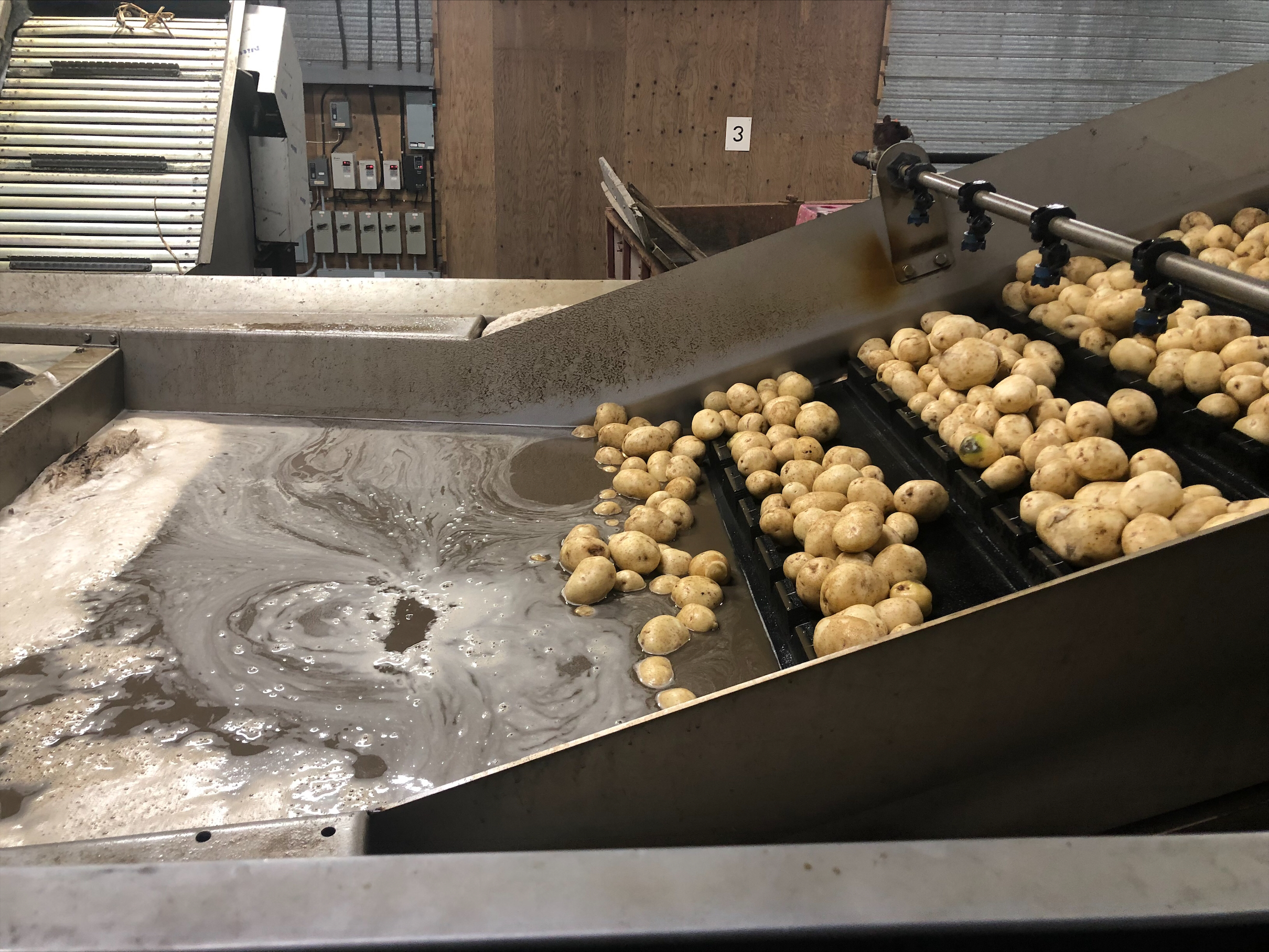
All uniform in size and shape, the potatoes roll and jostle past us as they’re siphoned onto a conveyor belt, and through a sorting machine which finds and removes tubers that are too small or imperfect to process. Peter produces potatoes used for potato chips, so his harvest needs to meet strict size and quality metrics set by his buyers–predominantly FritoLay (PepsiCo), Walmart, and Utz. The thing about ‘chipping’ potatoes is that they need to have very specific glucose and fructose levels for them to be fried. The varieties we produce are low in sugar, they were intentional developed as such. If a potato is too small, the sugars don’t develop properly, and it won’t produce a marketable potato chip. Plus, the large chip companies who buy these potatoes use mechanized processing: an operation requiring uniformity in size.
|
“Like any perishable, [potato] storage is critical. If they are stored improperly, they can rot or sprout and become inedible. But different kinds of potatoes (table, seed, chip) require different storing conditions.” |
After passing their sorting test, the tubers roll down another large red conveyer belt, with two workers doing manual Quality Control (checking for size and deformations), before disappearing into one of the property’s six 18ft tall storage buildings. The large garage doors of the building are pulled open, revealing a seemingly endless chasm of potatoes stored in boxes. We climb a set of stairs at the side of the building and come to a long narrow hallway. Peter lifts a wooden panel, and suddenly we’re looking at 18ft, roughly 1200 tons, of potatoes. And this was just one of 18 storage bins contained within the property’s 6 Quonset huts.
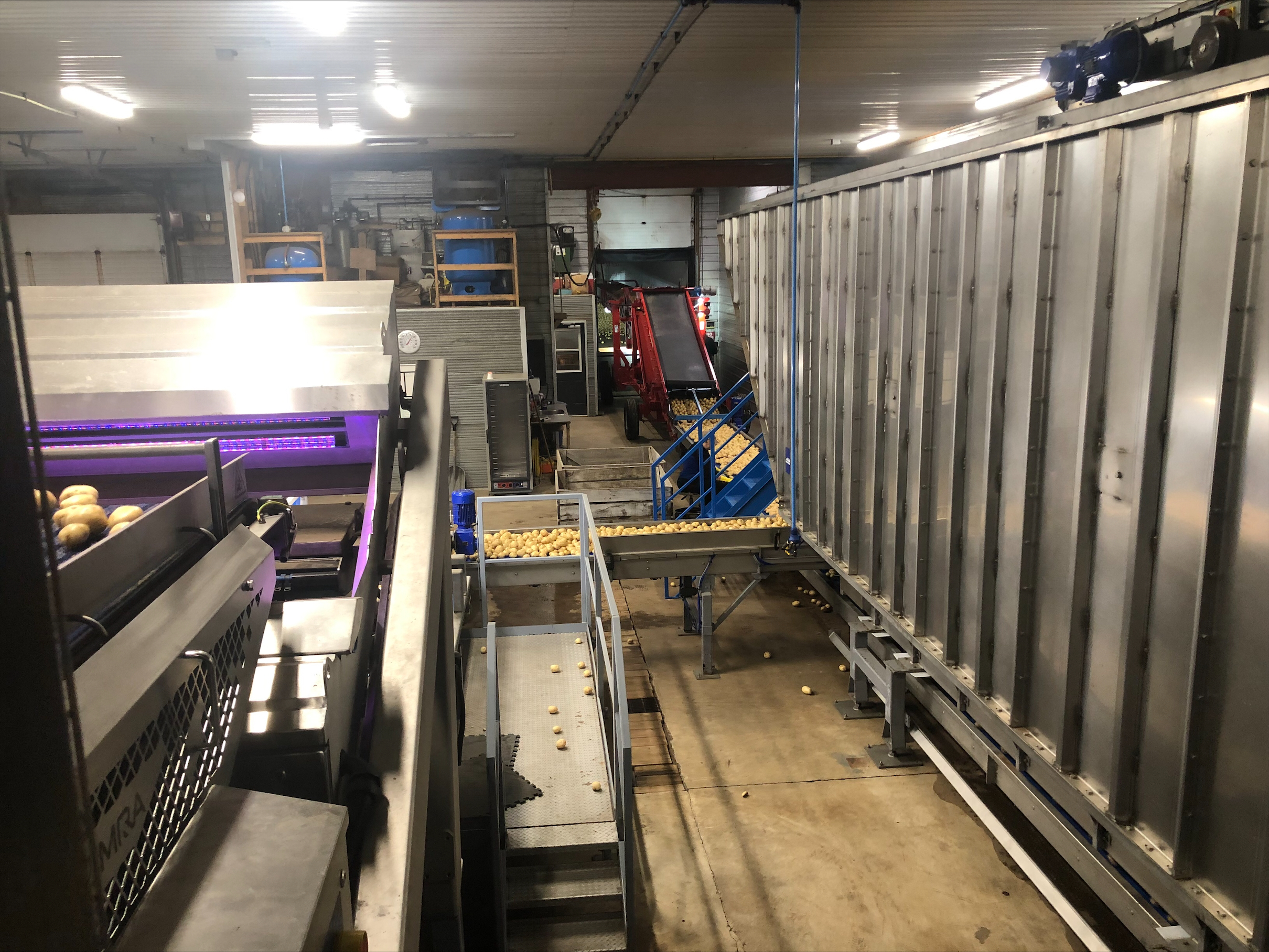
“These will be stored here until July if we’re lucky–about ten to eleven months”, Peter notes. But at Sunrise, luck has nothing to do with it.
Potatoes in Ontario are grown for 4 primary uses: Table (fresh, what you would buy in the produce aisle in the grocery store or farmer markets); Seed (used by farmers to grow more potatoes with quality of seeds – free of diseases, degeneration, or physical damage); Fries (usually processed and frozen); and for potato chips. Like any perishable, storage is critical. If they are stored improperly, they can rot or sprout and become inedible. But different kinds of potatoes (table, seed, chip) require different storing conditions. Potatoes used for table consumption or seed need to be stored in temperature-controlled conditions at around 2-5 degrees Celsius, while chipping potatoes require around 8-9 degrees. These slightly higher temperatures are essential for managing the development of sugars (sucrose, glucose) in the tuber–an important consideration for chips, but less important for seed or table.
“The potatoes that we keep in these containers can’t fluctuate in temperature by more than 5 degrees” Peter explains – because if they’re shocked, starch turns into sugar, rendering them unusable by larger processing companies. But it’s not just about temperature – if the CO2 levels get too high or humidity levels drop too low (below 99%), Peter risks losing his whole crop.
Closing the hatch at the top of the potato pile, we descend the wooden stairs and Peter shows us the special piece of tech that makes this all possible. He walks us over to a set of digitized panels on the wall, showing various metrics and readings. The brand name is ‘Techmark’, and he tells us that this piece of machinery was purchased in 1999, making him one of the first to bring this technology to Canada from the United States. “For me, this is a Best Management Practice…without it, none of this would be possible”, he notes.
We move on down the hall and away from the storage bins and walk past two farm workers chatting and drinking coffee on their break. They’re a father and son from Mexico, employed through a provincial foreign workers program in Ontario called F.A.R.M.S and they’ve been working with Peter for over 20 years. Peter admits that without the consistent help of workers brought in through this sort of program, running a farm of this size would be difficult.
We step into a large room, meeting back up with the potatoes that we saw being sorted at the beginning of our tour. It looks a bit like a factory floor with large machines humming, moving potatoes through metal apparatuses over our heads and around us. Peter takes us to the central machine in the room, bringing us up its stairs to see what’s going on. Here, potatoes are pushed through a hole in the wall, down a ramp and into a vat of muddy water where they slosh around to remove the dirt. Freshly cleaned, the potatoes then move down a belt, passing under a purple ultraviolet light before disappearing again. Used to detect disease and rot, this light is another step in quality control, catching and removing about 1.1% of unfit potatoes. The remaining potatoes move through another cleaning and sorting machine before the end of their journey. At the end of the line, two women sitting on stools manually check the remaining vegetables as they roll past: one last review to make sure there are no rotten or small spuds that made it through.
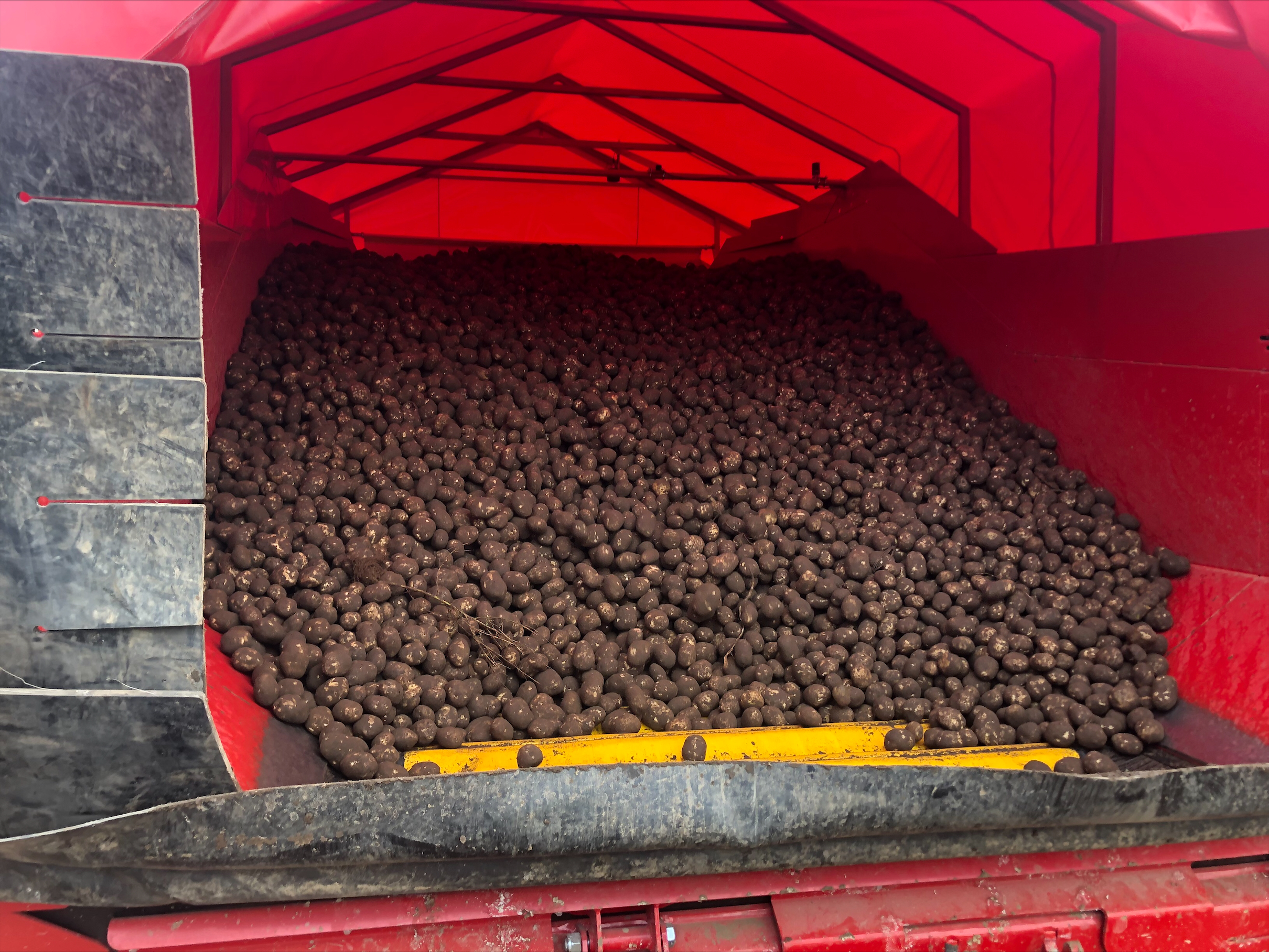
What we’ve just witnessed is an example of a highly technical, modern and efficient potato storage operation, and an essential stage in management and production for a farm of this size. Storage can make or break the success of a potato crop, but it’s just one of several important factors in the life cycle of this vegetable. Just like on-field farming systems which vary from small to large scale, organic to conventional, modern, or traditional, the other aspects of agricultural production, including storing, shipping, processing, packing, and selling can also be managed differently. These stages represent the complete picture of a production system.
Why is this important? Agriculture is responsible for 10% of Canada’s Greenhouse Gas emissions (Agriculture Canada, 2020) as well as significant land use change or degradation and biodiversity loss–all major contributors to climate change. Given the scale and impact of resource-intensive industrial agriculture, to meet our sustainability goals, significant changes in food production are needed. But what should those changes look like?
|
“Given the scale and impact of resource-intensive industrial agriculture, to meet our sustainability goals, significant changes in food production are needed..” |
This question is not easy to answer–and making agriculture more sustainable means making our food system and supply chains sustainable. Food systems are long value chains of producers, processors, agri-business, storage, transport, consumers, and governments, and everyone along the value chain has a role to play in the sustainability of food production. Farmers make decisions based on consumer preferences, government policies, corporate requirements, and the realities of their natural environments, but some have more power and flexibility to cope and challenge how these various groups impact their production systems.
Small-scale farmers can usually operate using less resource-intensive methods because they make choices about who their consumers will be. They often sell directly to local consumers through Community Supported Agriculture (CSA) models or at farmers’ markets, and opt out of working with larger manufacturers, processors, or retailers. This gives them the flexibility to use less intensive styles of farming, but it's often difficult to be economically viable as a small-scale producer.
Contracts with large companies like Frito-Lay, Walmart, PepsiCo, Cavendish or McCain usually include specific requirements for the quantity, variety, size, and quality of potatoes. To meet these standards farmers often rely on mechanized, intensive production which requires more mechanized and inorganic resources with a greater ecological impact. But for farmers faced with high amounts of debt from land ownership and farm operation costs, this may be their only option.
Just like the choices that small-scale farmers make away from the farm which impact the sustainability of their on-farm production, large-scale farmers also find innovative ways to be sustainable, even within a rigid system. Peter’s storage site shows us that, without substantial financial resources to manage the sort of technical, high-volume operation we saw at Sunrise, it is virtually impossible for small-scale producers to produce chipping potatoes. His operation is made viable because of the technology used to sort and store his potatoes. But it’s also expensive and requires the kind of scale that Peter’s able to produce. In Peter’s case, he’s able to substantially reduce food waste by using technology effectively and making smart management decisions. What Sunrise Potato Farm shows us is how sustainability can be operationalized at a commercial level, integrating Best Management Practices into the agri-food system.
Farmers face economic pressure to produce in high volume, so they make management decisions based on the guidelines they’re given. Cheaper and available land, lower production costs, less powerful agri-food and processing companies, and stronger local markets are critical aspects of sustainable agriculture–and they extend way past the farmer or the field.
So what does this mean for sustainability? We can start by recognizing that there can be sustainability at any farm size and scale, and on any given farm some practices will be environmentally friendly, and some won’t be. Farms are just one part of a wide production network, and while large and small farmers are both making trade-offs and sacrifices based on the realities of the food system, there’s no pathway towards sustainability without support all along the value chain.
|
“Farms are just one part of a wide production network, and while large and small farmers are both making trade-offs and sacrifices based on the realities of the food system, there’s no pathway towards sustainability without support all along the value chain.” |
Note: This [research] project is funded by the Ontario Ministry of Agriculture, Food and Rural Affairs (OMAFRA), through the Ontario Agri-Food Innovation Alliance.
References
- Government of Canada / Gouvernement du Canada. (2022, December 9). Government of Canada. Language selection - Agriculture and Agri-Food Canada / Sélection de la langue - Agriculture et Agroalimentaire Canada. Retrieved December 9, 2022, from https://agriculture.canada.ca/en/environment/greenhouse-gases
- Ontario Ministry of Agriculture, Food and Rural Affairs. (n.d.). Best Management Practices Series. OMAFRA. Retrieved December 9, 2022, from http://omafra.gov.on.ca/english/environment/bmp/series.htm
- Statistics Canada. (2016, January 25). Ontario led in soybeans and corn area. Ontario Provincial Trends. Retrieved December 9, 2022, from https://www150.statcan.gc.ca/n1/pub/95-640-x/2011001/p1/prov/prov-35-eng.htm
- Sustainable Agricultural Initiative Platform. (n.d.). SAI Platform: Our commitment. SAI Platform. Retrieved December 13, 2022, from https://saiplatform.org/our-value/our-commitment/#:~:text=What%20is%20sustainable%20agriculture%3F,welfare%20of%20all%20farmed%20species.
 Charlotte Potter is a Ph.D. Candidate in the Rural Studies program at the University of Guelph with a B.A. in Anthropology from Carleton University and an M.Sc. in Anthropology from University College London. Investigating the connection between knowledge, culture, and agriculture, Charlotte's research aims to contribute towards sustainable agricultural transitions by understanding processes of transformation in social, ideological, and knowledge systems.
Charlotte Potter is a Ph.D. Candidate in the Rural Studies program at the University of Guelph with a B.A. in Anthropology from Carleton University and an M.Sc. in Anthropology from University College London. Investigating the connection between knowledge, culture, and agriculture, Charlotte's research aims to contribute towards sustainable agricultural transitions by understanding processes of transformation in social, ideological, and knowledge systems.
 Silvia Sarapura is a professor in the School of Environmental Design and Rural Development at the University of Guelph. Her interdisciplinary research background connects biophysical and social science in agri-food planning. Silvia’s research contributes to transitions to sustainable and resilient agri-food systems.
Silvia Sarapura is a professor in the School of Environmental Design and Rural Development at the University of Guelph. Her interdisciplinary research background connects biophysical and social science in agri-food planning. Silvia’s research contributes to transitions to sustainable and resilient agri-food systems.
Note: The opinions expressed in this article are the responsibility of the authors and do not necessarily reflect the opinion of IICA.
|
If you have questions or suggestions for improving the BlogIICA, please write to the editor: Joaquín Arias |
Add new comment